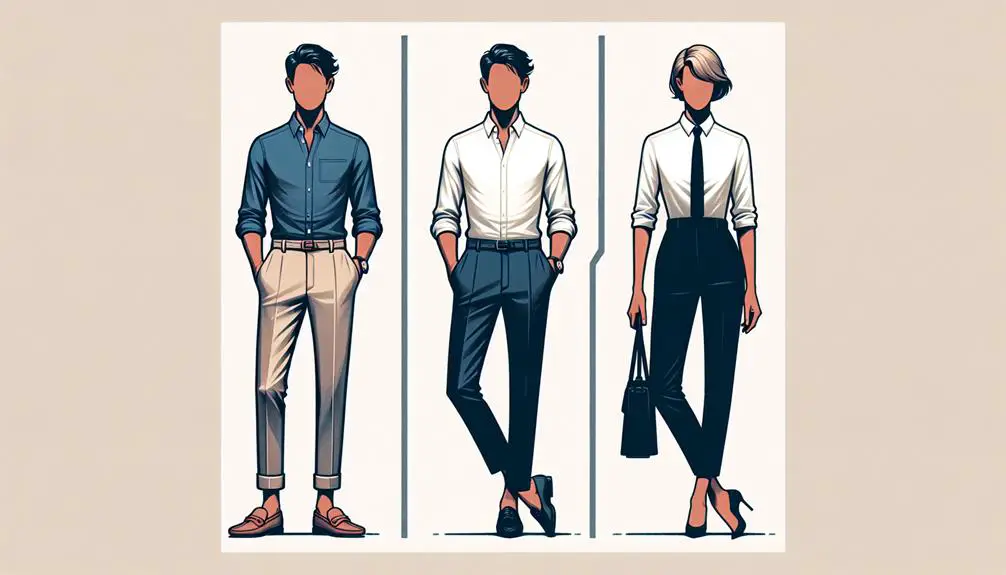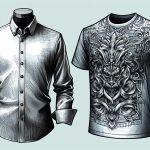Navigating the thin line between smart casual and business casual can sometimes feel like deciphering a secret code in the fashion world. The distinction between these two dress codes is crucial yet subtle, with each offering its unique blend of style and professionalism.
But fear not, for I am here to unravel the mystery behind the varying degrees of formality and flair in these commonly confused attire choices. Let's explore the nuances that set smart casual and business casual apart, shedding light on when to opt for one over the other to strike that perfect sartorial balance.
Table of Contents
Key Takeaways
- Business casual leans towards professional with muted colors, while smart casual embraces trendier and brighter tones.
- Business casual incorporates button-down shirts and dress pants, while smart casual opts for tailored trousers and knit polo shirts.
- Accessories in business casual are minimalistic for sophistication, whereas smart casual allows stylish additions to elevate the look.
- Business casual is suitable for semi-formal events, while smart casual is ideal for upscale occasions like weddings and cocktail parties.
Key Elements of Business Casual
When navigating the realm of business casual attire, it's essential to understand the key elements that define this versatile dress code. Business casual blends the professionalism of traditional business wear with the comfort of more casual styles. A typical business casual outfit may consist of a button-down shirt paired with dress pants, offering a smart yet relaxed look suitable for professional settings. While a full suit isn't required, it's important to choose clothing that's neat, well-fitted, and appropriate for the workplace.
In addition to the classic shirt and pants combination, business casual allows for the incorporation of more casual elements like khakis, sweaters, and loafers. Accessories play a crucial role in elevating a business casual ensemble, with belts, watches, and understated jewelry adding a polished touch. The key to mastering business casual lies in striking the right balance between professionalism and comfort, ensuring you look both sharp and approachable in your attire.
Distinctive Features of Smart Casual
Blending trendier pieces with classic staples, smart casual attire achieves a polished yet relaxed look. It strikes a balance between professionalism and comfort, making it less formal than business attire while still exuding confidence.
The key to mastering the smart casual look lies in combining classic elements like tailored trousers or skirts with more contemporary pieces such as knit polo shirts or sleek blouses. Coordinating colors and textures is essential to creating a cohesive and stylish outfit.
For men, incorporating good jackets and dark jeans can elevate the ensemble, while women can opt for unstructured jackets, pleated trousers, and modern loafers for a chic yet professional appearance. Ultimately, smart casual is about looking put together while feeling at ease, allowing individuals to showcase their personal style in a modern and versatile way.
Color Palette Variations
Moving from the distinctive features of smart casual, let's now explore the color palette variations that differentiate between business casual and smart casual attire. Business casual attire often sticks to a more professional color scheme, including navy, grey, dark brown, and sage. These muted contrasting colors offer a professional yet relaxed look suitable for the workplace. In contrast, smart casual allows for a bit more flexibility with colors, incorporating lighter and brighter tones while still maintaining a sense of balance. Smart casual outfits typically limit the overall color palette to three shades to avoid overwhelming the look.
When it comes to selecting colors, business casual leans towards a subtle color palette, aiming for a classy appearance. Avoiding loud and bright colors like yellow or red is common practice in business casual settings. On the other hand, smart casual outfits focus on a balanced color scheme that exudes a classy yet relaxed vibe. By incorporating bright colors sparingly and opting for a more refined selection, smart casual attire strikes the perfect balance between professional and stylish.
Accessories and Their Significance
Accessories serve as key elements in elevating the overall appeal of both smart casual and business casual outfits. When it comes to these dress codes, choosing the right accessories can make a significant difference in your overall look. Here are some essential points to consider:
- Minimalism in Business Casual: In a business casual setting, less is often more. Opt for minimal accessories like a sleek watch or a subtle tie clip to maintain a polished and professional appearance.
- Stylish Additions for Smart Casual: Smart casual attire allows for more creativity. Consider adding stylish elements like a pair of trendy sunglasses or a vibrant pocket square to inject personality into your outfit.
- The Belt Matters: In business casual, the right belt can pull your entire look together. Make sure to match the belt color with your trouser shade for a cohesive appearance.
- Classic Leather Shoes: Leather shoes are a timeless choice that works well for both smart casual and business casual outfits, adding a touch of sophistication to your overall ensemble.
Occasions for Each Dress Code
For different events, knowing when to rock a business casual or smart casual outfit can elevate your style game and leave a lasting impression. Business casual is perfect for occasions like casual Fridays in the office, semi-formal meetings, or even a stylish date look. It offers a professional and chic appearance that's suitable for formal events where you want to look put together without being too overdressed.
On the other hand, smart casual is ideal for events outside the office, such as weddings, cocktail parties, or date nights. This dress code exudes class and elegance, making it a great choice for upscale clientele or special occasions where you want to look fashionable yet feel comfortable.
Both business casual and smart casual cater to different occasions, with business casual focusing on a professional look and smart casual leaning towards a stylish and trendy vibe. Choosing the right dress code for each occasion can help you make a strong and stylish statement effortlessly.
Frequently Asked Questions
Is There a Difference Between Smart Casual and Business Casual?
Oh, the distinction between smart casual and business casual? Absolutely! Smart casual is effortlessly chic, while business casual is more polished. Knowing the nuances helps me navigate various settings with style and confidence.
Can You Wear Jeans in Smart Casual?
I can wear jeans in smart casual if they are dark, well-fitted, and free of distressing or embellishments. Opt for high-quality denim in a tailored fit to maintain a polished appearance and pair with a blazer and smart shoes for a sophisticated look.
What Is Acceptable for Smart Casual?
In smart casual attire, I love pairing trendy pieces with classic staples. For men, knit polo shirts, good jackets, and dark jeans work well. Women can choose sleek blouses, unstructured jackets, pleated trousers, and modern loafers for a polished look.
What Is Dress Code Smart Casual?
Smart casual dress code allows me to blend trendy and classic pieces for a polished yet relaxed look. It's about appearing stylish, professional, and approachable. Think dark jeans, sleek blouses, and modern loafers for this versatile attire.
- What Is Calf Suede Fabric? - July 12, 2025
- Should You Use Interfacing With Suede Fabric? - July 12, 2025
- The Best Way to Clean a Suede Fabric Sofa From Oil Stains - July 12, 2025







